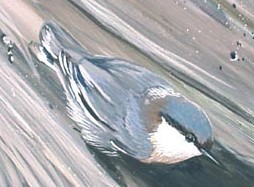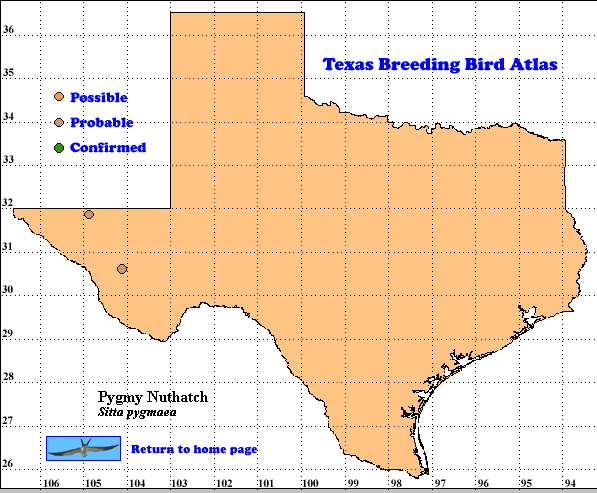Pygmy Nuthatch is a conspicuous inhabitant of long-needled pine forests in western North America. Small flocks, often family groups, chatter as they forage on the bark and needles of pines, searching for weevils and bark and needle beetles. Pine seeds form another important part of the diet. This social species participates in same species feeding flocks and also in mixed species flocks in winter. These nuthatches roost on cold winter nights in cavities which may hold as many as 150 birds. While socially ,monogamous, many nests are attended by unmated males, usually relatives, who help feed the incubating female, nestlings and fledglings and also assist with nest defense.
Many aspects of the behavior of Pygmy Nuthatch are similar to those of Brown-headed Nuthatch (S. pusilla), its closest relative which breeds in eastern Texas. Although some considered them conspecific in the past and they probably evolved from a common ancestor, recent studies support their retention as separate species (Kingery and Ghalambor 2001).
DISTRIBUTION. During the 1987-1992 field work for the TBBA project, researchers found probable breeding evidence for Pygmy Nuthatch in the Guadalupe (4 records) and Davis (1 record) mountains, the same areas where Oberholser (1974) reported breeding. Lockwood and Freeman (2004) describe this nuthatch as a resident in these mountains. The TBBA records probably all represent actual breeding.
In other areas Pygmy Nuthatches reside in long-needled pine forests, especially ponderosa and Jeffereypines, from British Columbia to the Isthmus of Tehuantepec in Mexico and from the Pacific Coast to western Montana, the Black Hills of South Dakota, western Nebraska, Colorado and New Mexico (Kingery and Ghalambor 2001).
SEASONAL OCCURRENCE. Breeding probably occurs from late April to late July (Oberholser 1974, Lockwood and Freeman 2004). In Colorado atlasers found breeding evidence from May 7 to August 25 (Jones 1998), and in Arizona breeding evidence was recorded from April 20 to August 1 (Spence 2005).
BREEDING HABITAT. A nest was found in the Guadalupe Mountains at about 2300-2600 m (7500-8500 ft) where stands of ponderosa pine are often mixed with oak or Douglas fir (Oberholser 1974). In Arizona 92% of breeding occurred in habitats containing ponderosa pine (Spence 2005), and in Colorado 93% of atlas observations were in coniferous forests (Jones 1998). Nests are often placed in cavities in the trunk of live or dead trees. As many as 73% of cavities are excavated by the pair; other nests are in natural cavities, old woodpecker holes or nest boxes. The average cavity depth is about 15 cm (6 in). The cavity is lined with bark shreds, insect cocoons, hair, plant down, or feathers.
The female usually lays 7 (range 5-9) white eggs (see Harrison [1979] for photo of markings) which she incubates for about 15 days. Young birds leave the nest at 14-22 days after hatching. Helpers participate in raising the young at as many as 40% of all nests and pairs usually raise only 1 clutch per season (Harrison 1979).
STATUS. Lockwood and Freeman (2004) characterize Pygmy Nuthatch as an uncommon resident in the upper elevations of the Guadalupe Mountains and rare in the Davis Mountains. The North American Breeding Bird Survey does not sample this nuthatch in Texas; data from 147 routes across the United States and Canada produce a 95% confidence interval (There is a 95% chance that the actual population trend will be between these two numbers.) of -1.1 to +1.9% population change per year for the period 1966-2004 (Sauer et al 2005). This relatively small change is encouraging for the future of this species in Texas.
Text by Robert C. Tweit (2006)
Literature cited.
Harrison, H. H. 1979. A field guide to western birds’ nests. Houghton Mifflin, Boston, MA.
Jones, S. L 1998. Pygmy Nuthatch (Sitta pygmaea). In Colorado breeding bird atlas, pp. 360-361 (H. E. Kingery, ed.., Colorado Bird Atlas Partnership, Denver.
Kingery, H. E. and C. K. Ghalambor. 2001. Pygmy Nuthatch (Sitta pygmaea). In The birds of North America, No. 567 (A. Poole and F. Gill, eds.). The Birds of North America, Inc., Philadelphia, PA.
Lockwood, M. W. and B. Freeman. 2004. The TOS handbook of Texas birds. Texas A&M University Press, College Station.
Oberholser, H. C. 1974. The bird life of Texas. Vol. 2. University of Texas Press, Austin.
Sauer, J. R., J. E. Hines, and J. Fallon. 2005. The North American Breeding Bird Survey, results and analysis 1966-2004. Version 2005.1. USGS Patuxent Wildlife Research Center, Laurel MD (Web site, http://www.mbr-pwrc.usgs.gov/bbs).
Spence, J. R. 2005. Pygmy Nuthatch (Sitta pygmaea). In Arizona breeding bird atlas.p p. 398-399 (T. E. Corman and C. Wise-Gervais, eds.). University of New Mexico Press, Albuquerque.

